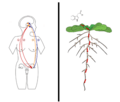Hormone facts for kids

Hormones are like special chemical messengers in your body. They are part of your endocrine system, which works with your nervous system to control how your body works inside. Every living thing with many cells has hormones.
Hormones send signals that help your body adjust. Cells that need to "hear" a hormone's message have special "receptors." These receptors are like tiny locks that only a specific hormone key can open. When a hormone connects to its receptor, it starts a chain reaction inside the cell. The cell or body part that gets the message is called the 'target'. Hormones only affect cells with the right receptors.
Many types of cells can send these chemical messages. Some cells are specially designed to make hormones. When many of these cells are together in one place, they form a gland. Glands are groups of cells that make and release substances. Many glands make hormones.
The word "endocrine" means releasing something directly into the blood. Most hormones are released this way from endocrine glands. The opposite is "exocrine," which means releasing something through a tube or duct. Some hormones come from exocrine glands. For example, Sweat glands and Salivary glands are exocrine glands. Their products, like sweat and saliva, are released outside the body.
Contents
What Hormones Do
Hormones do many important jobs in your body.
Controlling Body Processes
They help control your metabolism. Metabolism is all the chemical reactions and energy changes happening in your body. Hormones also guide the growth and death of cells, and even your whole body.
Growth and Development
Hormones also start and control how your body develops sexually. For example, hormones like estrogen and progesterone cause girls to go through puberty.
Keeping Balance (Homeostasis)
Hormones help keep your body in a steady state, called homeostasis. This means keeping things like your body temperature, water levels, salt amounts, and sugar levels constant. Hormones released by one gland can even tell other glands to make different hormones.
Types of Hormones
In most animals with backbones, like humans, there are four main types of hormones. They are grouped by what chemicals they are made from.
- Steroid hormones: These are made from cholesterol. Examples include sex hormones like estradiol and testosterone. The stress hormone cortisol is also a steroid hormone.
- Eicosanoids: These are lipid hormones, meaning they are made from fats. They often send messages to cells very close to where they are made.
- Amino acid derived hormones: These come from amino acids, which are the building blocks of proteins. Melatonin works on the brain, and thyroxine affects almost all cells. Many of these hormones are also neurotransmitters, which are chemicals nerve cells use to talk to each other.
- Peptides and proteins: These are made of chains of amino acids. Small peptide hormones include TRH and vasopressin. Larger ones, with many amino acids, are called proteins. Examples of protein hormones are insulin and growth hormone. Some protein hormones have sugar parts attached and are called glycoprotein hormones, like Luteinizing hormone and follicle-stimulating hormone.
How Hormones Are Controlled
In biology, "regulation" means controlling something. So, regulating hormones means controlling how many hormones are made and released from cells.
Negative Feedback
Most hormones are controlled by something called negative feedback. This is like a thermostat. When a hormone causes an effect, the cells that make the hormone sense this effect. Then, they stop making more of that hormone.
A good example is insulin. Your pancreas makes insulin. When you eat, your blood glucose (sugar) level goes up. Your pancreas senses this rise and releases insulin into your blood. Insulin tells your body cells to take sugar out of the blood. Some sugar is used, and some is stored as glycogen. As cells take up sugar, your blood sugar level goes down. Your pancreas then senses this drop and stops releasing insulin. This negative feedback helps keep your blood sugar levels normal and prevents big changes.
Counter-Regulatory Hormones
Sometimes, two or more hormones control the same thing. Blood sugar is very important, so it's not controlled by just insulin. If your blood sugar gets too low, your body releases hormones that do the opposite of insulin. They tell cells to put sugar back into the blood. These hormones are called counter-regulatory hormones. For insulin, the counter-regulatory hormones are glucagon and epinephrine.
Positive Feedback
Most important body functions are kept steady by negative feedback. However, a few things are controlled differently. One rare way is positive feedback. In negative feedback, the hormone's effect tells the gland to stop making hormones. In positive feedback, the opposite happens. The effect of the hormone tells the gland to make even more hormones.
An example of positive feedback is the hormone that causes childbirth. This hormone is called oxytocin, and your pituitary gland makes it. When the baby starts to come out, it stretches the muscles in the cervix (the bottom part of the uterus). Nerves in the cervix send a message to the pituitary gland. This message makes the pituitary release more oxytocin. The oxytocin then makes the uterus muscles squeeze harder. This causes more stretching in the cervix, which tells the pituitary to make even more oxytocin. So, oxytocin levels keep rising until the baby is born.
Hormones vs. Neurotransmitters
Hormones and neurotransmitters are both chemical messengers, but they work differently.
- Hormones can travel throughout your body in the blood. They can affect many places and take longer to act (seconds, minutes, or hours).
- Neurotransmitters travel along specific nerve pathways. They act much faster (milliseconds) and only affect cells connected to those nerves.
- Nerve signals are like an "on" or "off" switch. Hormone signals can be more varied, depending on how much hormone is present.
How Hormones Connect to Cells
Most hormones start a cell's response by connecting to special spots called receptors. These receptors can be on the cell's outer membrane or inside the cell. A cell might have different types of receptors that recognize the same hormone but cause different actions. Or, a cell might have different receptors for different hormones that lead to the same action.

Right: Protein hormones (1) connect to receptors on the cell's surface (2). This triggers a signal pathway inside the cell. (3) Special factors are activated in the nucleus, and protein making begins. In both pictures, 'a' is the hormone, 'b' is the cell membrane, 'c' is the cytoplasm, and 'd' is the nucleus.
Images for kids
-
Left: A hormone feedback loop in a female adult. (1) Follicle-Stimulating Hormone, (2) Luteinizing Hormone, (3) Progesterone, (4) Estradiol. Right: Auxin transport from leaves to roots in Arabidopsis thaliana
See also
 In Spanish: Hormona para niños
In Spanish: Hormona para niños



